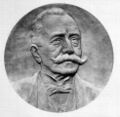Template:Selected anniversaries/March 15: Difference between revisions
No edit summary |
No edit summary |
||
| Line 10: | Line 10: | ||
||1783: In an emotional speech in Newburgh, New York, George Washington asks his officers not to support the Newburgh Conspiracy. The plea is successful and the threatened coup d'état never takes place. | ||1783: In an emotional speech in Newburgh, New York, George Washington asks his officers not to support the Newburgh Conspiracy. The plea is successful and the threatened coup d'état never takes place. | ||
||1806: A six kilogram chondritemeteorite - carrying carbon-based, organic chemicals - was unequivocally identified for the first time. Its arrival on earth was noted at 5:30 pm, outside Alais, France. The organic chemicals it carried suggested the possibility of life on whatever body was the source, somewhere in the universe. According to the observations of Berzelius and a commission appointed by the French Academy it "emits a faint bituminous substance" when heated. Berzelius reported his analysis of the Alais meteorite in 1833 that destructive distillation yielded a blackish substance, indiginous water, carbon dioxide gas, a soluble salt containing ammonia, and a blackish-brown sublimate, which Berzelius confessed was unknown to him. *TIS https://pballew.blogspot.com/2019/03/on-this-day-in-math-march-15.html | ||1806: A six kilogram chondritemeteorite - carrying carbon-based, organic chemicals - was unequivocally identified for the first time. Its arrival on earth was noted at 5:30 pm, outside Alais, France. The organic chemicals it carried suggested the possibility of life on whatever body was the source, somewhere in the universe. According to the observations of Berzelius and a commission appointed by the French Academy it "emits a faint bituminous substance" when heated. Berzelius reported his analysis of the Alais meteorite in 1833 that destructive distillation yielded a blackish substance, indiginous water, carbon dioxide gas, a soluble salt containing ammonia, and a blackish-brown sublimate, which Berzelius confessed was unknown to him. *TIS https://pballew.blogspot.com/2019/03/on-this-day-in-math-march-15.html | ||
Revision as of 20:13, 26 January 2022
44 BC: Julius Caesar, Dictator of the Roman Republic, is stabbed to death by Marcus Junius Brutus, Gaius Cassius Longinus, Decimus Junius Brutus, and several other Roman senators on the Ides of March.
1897: Mathematician and academic James Joseph Sylvester dies. He made fundamental contributions to matrix theory, invariant theory, number theory, partition theory, and combinatorics.
1900: Mathematician and physicist Elwin Bruno Christoffel dies. He introduced fundamental concepts of differential geometry, opening the way for the development of tensor calculus, later providing the mathematical basis for general relativity.
1912: Mathematician Cesare Arzelà dies. He contributed to the theory of functions, notably his characterization of sequences of continuous functions.
1962: American physicist and academic Arthur Compton dies. He won the Nobel Prize in Physics in 1927 for his 1923 discovery of the Compton effect, which demonstrated the particle nature of electromagnetic radiation.




